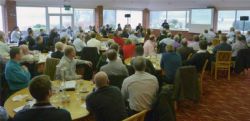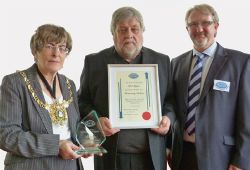Exhaust Ventilation Engineers) has been established as the fourth Division within CIBSE to represent those involved in this specialist area. It currently has over 120 registered members which it hopes to increase to 250. The Institute was formed to bring about a significant reduction in the deaths and ill health caused by poor air quality in the workplace.

Assembled delegates
On 24 January, ILEVE held an Information Day attended by over 100 delegates to review the progress in its development, state its objectives, explain the benefits of membership and provide a forum for members and other interested parties to discuss the future proposals for the Institute.
One highlight of the day was a presentation by the Lord Mayor of Sheffield to Phil Hydes who has become recognised within the industry by his adoption by HSE in a video interview where he explained how the lack of proper ventilation during his time as an industrial welder has left him severely incapacitated.
The day began with Bud Hudspith, Health and Safety Advisor for the Unite Union, saying how important the work of ILEVE was to create healthy working conditions and how there was still much to be done in this area. Organisations such as Unite and HSE have worked hard to explain and promote the need for LEV, but there are still instances to be found where people work in unsatisfactory conditions.

The Lord Mayor of Sheffield, Phil Hydes & Wally Gilder
Wally Gilder, chair of the ILEVE Steering Committee, summarised the beginnings of ILEVE and how it became a Division within CIBSE. From an initial idea voiced at a presentation to the industry, strongly supported by HSE who recognised that serious problems existed, it is now a representative voice with firm plans to develop a professionally led Institute.
Dean Greer, chair of the Membership and Grading subcommittee, explained the proposals for establishing different grades for all those registered with the Institute. The grading structure already used by CIBSE is to be adopted. All registrants have initially been made affiliate members. A detailed application form to identify qualifications and experience has been produced to allow a 'Grandfather' route to other grades. Each application will be individually assessed by the Steering Committee and given the appropriate grade. This route will only be open for a limited period (to December 2012). In parallel with this there will be a route by training and examination to advance through membership grades.
Tony Gardner from the Training and Technical sub-committee, explained the proposals for the ILEVE training programmes. Much will be based on existing, recognised courses that are accepted within the industry. Discussions have taken place with training providers and course material providers such as BOHS. It is hoped that a comprehensive package of training courses will be available for members and non-members by mid-2012.
James Wheeler, HSE liaison officer for LEV, reminded the audience of the
issues relating to LEV as raised at the HSE roadshows around the UK. The roadshows had had a significant and effective result, raising awareness about LEV issues amongst manufacturers and other employers where LEV is in use. He also introduced Phil Hydes and the Lord Mayor of Sheffield.
Jane Bastow, ILEVE Steering Committee member explained the changes to HSG 258 Controlling airborne contaminants at work: A guide to local exhaust ventilation. This is a concise document supplemented by a simple guide, INDG408 and an employee's pocket guide INDG409. These can all be obtained from the HSE website www.hse.gov.uk/lev
Gary Sprawling introduced the new HVCA Guide to Good LEV practice.
Duncan Smith, HSE Specialist Inspector, provided some graphic illustrations of bad and good practice about LEV that he had found inspecting sites. Adrian Hurst, from University of Manchester Centre for Occupational Hygiene and Health, summarised the issues relating how inadequate LEV affects workers' health.
Past CIBSE President John Armstrong provided an update on how many ILEVE members had registered. He outlined his thoughts on an ILEVE Technical Design Guide, though from the lack of enthusiasm shown at the meeting for such a document, it appears to be not an immediate priority. He also addressed proposed ILEVE promotional leaflets for potential members and for employers.
Finally, John Whitehead, also from the ILEVE Steering Committee, introduced proposals for an industry partnership scheme.
The Urban Climate Project - part of an Engineering Doctorate sponsored by CIBSE at the Virtual Environments, Imaging and Visualisations Centre, UCL - is calling for input and contributions from CIBSE members and the wider sector.
The project will produce design guidance and knowledge resources for CIBSE members on the effect of building design within the context of the urban climate. Increasing urbanisation and projected climate change will exacerbate climatic effects on buildings. Previous CIBSE guides have provided a useful treatment of urban heat island effects, but this needs to be updated and expanded to include a wider range of microclimatic effects.
The research will analyse how land-use changes in urban environments impact the surrounding climate and the effect of microclimates on the performance of developments. The resulting guidance could include how changing a building's physical characteristics could impact the local climate and the effect of microclimates on performance criteria such as energy use, sizing and thermal comfort. This would produce design strategies that would lead to more comfortable, passive and sustainable design.
The above research will feed into the revision of Guide A as well as other current and future CIBSE resources. The effectiveness of the guidance will depend on its applicability to industry practices. The following questions need to be answered in order to achieve this:
Are urban environmental effects currently considered in a planning or design process? If so, how are they treated? What are the current industry drivers?
How useful is current CIBSE guidance on urban environmental effects? How could it be improved?
What would CIBSE members need in terms of practical tools and guidance on the treatment of urban environment in the context of the design of buildings?
To find out more about this research project and to get involved, please contact Dane Virk: dvirk@cibse.org